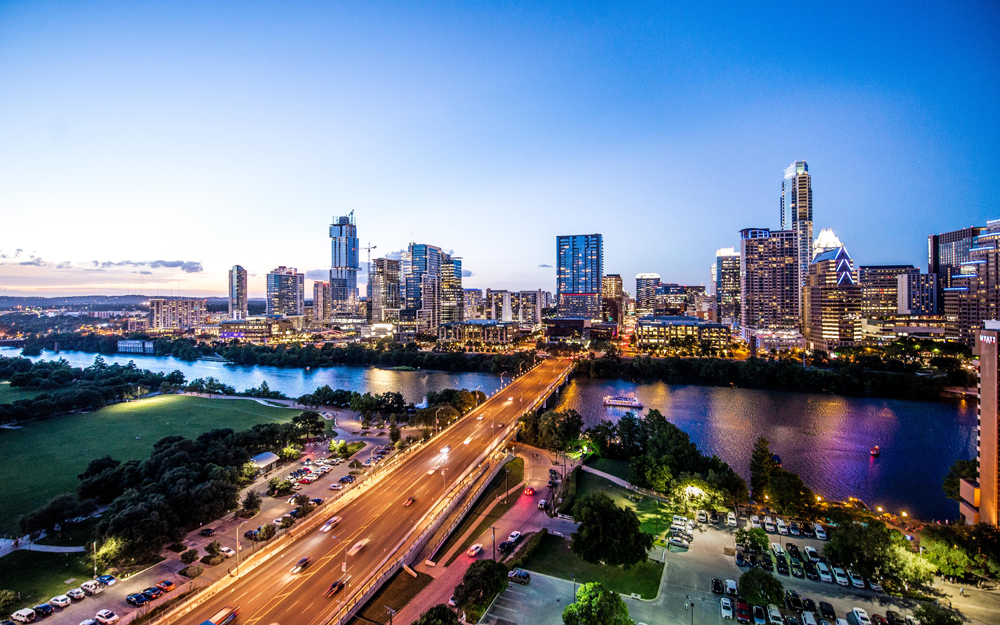
Austintonio? Austin and San Antonio getting closer to forming metroplex that rivals DFW
Claire Partain
In 2013, as the city of San Marcos was recognized as the nation’s fastest-growing city by the U.S. Census Bureau for the first time, journalist and entrepreneur Melissa Jewett knew a change was coming.
Central Texas earned a reputation as one of the fastest-growing hubs in the country throughout the mid-2010s as newcomers from near and far flocked and real estate prices soared. As the area began experiencing growing pains, Jewett saw an opportunity. She formed the online news site San Marcos Corridor News to serve not just San Marcos, but nearly the entire I-35 corridor between Austin and San Antonio.
“I have been in San Marcos for 16 years and I have just watched tremendous growth… and so I just decided that we needed to tap into that audience,” Jewett said. “I wanted something that could try to cover a regional area and not just a local area, even though that’s what I started out thinking about. And during those eight months, it finally hit me upside the head that it’s growing like crazy.”
While San Marcos’ Hays County exploded by over 50% to become the fastest-growing county in Texas from 2010-2020, Austin was heralded as a “boomtown” by new transplant Elon Musk and the thousands of techies that soon followed. The Texas capital city-turned Californian haven was the fastest-growing large metro in the country in 2020, according to the Census Bureau.
Just an hour and a half south down a short, traffic-heavy I-35 strip lies San Antonio, a city whose growth isn’t far behind its more hipster counterpart. San Antonio and nearby New Braunfels were once set apart by swaths of countryside; now, the two are nearly connected and are both earning spots on fast-growing lists.
With all of the past decade’s expansion, some believe that Austin and San Antonio will one day merge into a metroplex that rivals Dallas-Fort Worth. Some, including Jewett and state demographer Lloyd Potter, say it’s already happening.
Matthew McCafferty, a real estate developer with Brookfield Properties, said he remembers when Blanco Vista, their master-planned community in San Marcos, was one of the first in the area. Now, small subdivisions dot nearly the entire corridor. McCafferty said Austin bedroom town Buda has been nearly completely bought out by new developments, while New Braunfels currently has a massive 6,000-unit master-planned community in the works.
There are still some obstacles before the area becomes a metro with a catchy nickname—ASA (or Austintonio?). In their latest study published last month, Austin’s Urban Land Institute discussed several needs, including better public transportation and high-density walkable neighborhoods, if Austin is to have sustainable growth and increase affordability.
ULI’s Paulette Gibbins said that extends to I-35 corridor growth—the area’s cities will need to emphasize “transit-oriented development” and vastly improve travel time between the two hubs before it can experience healthy growth.
.
McCafferty said a public rail system and money funneled from the U.S. infrastructure bill could help the two cities grow together.
“That’s a heck of a drive in the morning (and) I think that that’s the biggest constraint between the two cities,” McCafferty said, referring to the hour and a half drive between the city centers (without traffic).
But even with lightning-speed rail to connect the two cities, the region wouldn’t be cohesive without “live, work and play” cities in between, Gibbins said.
“Having job opportunities so people can work near where they live, is also going to have a great effect on the (metro) overall because otherwise, you end up where it’s really just a split between the two cities,” Gibbins said. “The whole area needs to be utilized.”
That’s where organizations like the Greater San Marcos Partnership (GSMP) come in. San Marcos residents tend to grit their teeth when their city is referred to as a commuter city for Austin or San Antonio, and Jewett said some officials are in denial about the area’s imminent growth.
But San Marcos has become an economic powerhouse of its own—the partnership helped usher in a 1 million-square-foot Amazon warehouse in 2020, and the GSMP’s Jason Giulietti said the area’s job growth and labor force each grew by around 45% from 2008 to 2018. The city’s resident 36,000-strong university, Texas State University, is also quickly developing into a tier-one research institution.
Some families already brave the commute between the two Central Texas hubs each morning—but as residents and companies get priced out of Austin and San Antonio city centers, they’re turning to the in-betweener cities. According to ApartmentData.com’s November Market Line Report, the San Marcos/Kyle/Buda area has been the hottest of Greater Austin’s 11 submarkets over the last three months.
“If you think about as a large employer, choosing a site in San Marcos, Kyle or New Braunfels gives you the ability to pull from the Austin market as far as jobs and… the San Antonio market as well,” McCafferty said. “I think that’s going to become a lot more appealing.”
This story originally published by Austonia.







I was born in San Antonio and have lived all of my adult life in Austin. I have over forty years of at least monthly travel between the cities. Years ago, in a Facebook post, I explained why I thought the area was turning into a metroplex and suggested some nicknames. “Riverplex” due to the significance of the beautiful rivers flowing through San Antonio, New Braunfels, San Marcos, and Austin; “Tacoplex,” which hardly needs an explanation; and finally “Tex-MexPlex,” because it’s catchy.